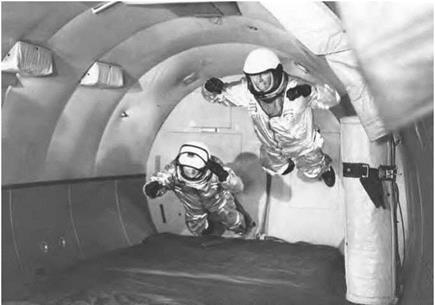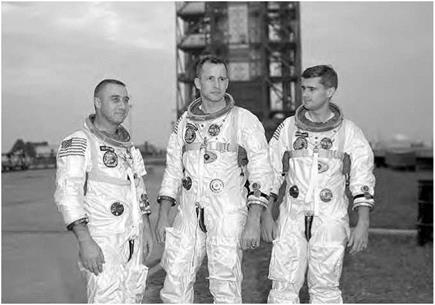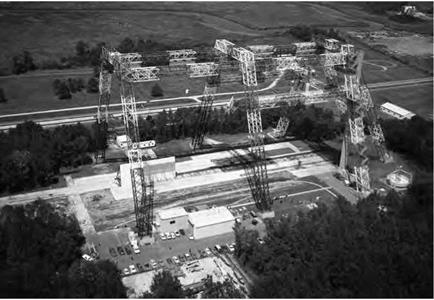Bioastronautics, Bioengineering, and Some Hard-Learned Lessons
Over the past 50 years, NASA has indeed encountered many complex human factors issues. Each of these had to be resolved to make possible the space agency’s many phenomenal accomplishments. Its initial goal of putting a man into space was quickly accomplished by 1961. But in the years to come, NASA progressed beyond that at warp speed— at least technologically speaking.[344] By 1973, it had put men into orbit around the Earth; sent them outside the relative safety of their orbiting craft to "walk” in space, with only their pressurized suit to protect them; sent them around the far side of the Moon and back; placed them into an orbiting space station, where they would live, function, and perform complex scientific experiments in weightlessness for months at a time; and, certainly most significantly, accomplished mankind’s greatest technological feat by landing humans onto the surface of the Moon—not just once, but six times—and bringing them all safely back home to Mother Earth.[345]
NASA’s magnificent accomplishments in its piloted space program during the 1960s and 1970s—nearly unfathomable only a few years before—thus occurred in large part as a result of years of dedicated human factors research. In the early years of the piloted space program, researchers from the NASA Environmental Physiology Branch focused on the biodynamics—or more accurately, the bioastronautics – of man in space. This discipline, which studies the biological and medical effects of space flight on man, evaluated such problems as noise, vibration, acceleration and deceleration, weightlessness, radiation, and the physiology, behavioral aspects, and performance of astronauts operating under confined and often stressful conditions.[346] These researchers thus focused on providing life support and ensuring the best possi-
|
Mercury astronauts experiencing weightlessness in a C-1 31 aircraft flying a "zero-g” trajectory. This was just one of many aspects of piloted space flight that had never before been addressed. NASA. |
ble medical selection and maintenance of the humans who were to fly into space.
Also essential for this work to progress was the further development of the technology of biomedical telemetry. This involved monitoring and transmitting a multitude of vital signs from an astronaut in space on a real-time basis to medical personnel on the ground. The comprehensive data collected included such information as body temperature, heart rate and rhythm, blood and pulse pressure, blood oxygen content, respiratory and gastrointestinal functions, muscle size and activity, urinary functions, and varying types of central nervous system activity.[347] Although much work had already been done in this field, particularly in the X-15 program, NASA further perfected it during the Mercury program when the need to carefully monitor the physiological condition of astronauts in space became critical.[348]
Finally, this early era of NASA human factors research included an emphasis on the bioengineering aspects of piloted space flight, or the application of engineering principles in order to satisfy the physiological requirements of humans in space. This included the design and application of life-sustaining equipment to maintain atmospheric pressure, oxygen, and temperature; provide food and water; eliminate metabolic waste products; ensure proper restraint; and combat the many other stresses and hazards of space flight. This research also included finding the most expeditious way of arranging the multitude of dials, switches, knobs, and displays in the spacecraft so that the astronaut could efficiently monitor and operate them.[349]
In addition to the knowledge gained and applied while planning these early space flights was that gleaned from the flights themselves. The data gained and the lessons learned from each flight were essential to further success, and they were continually factored into future piloted space endeavors. Perhaps even more important, however, was the information gained from the failures of this period. They taught NASA researchers many painful but nonetheless important lessons about the cost of neglecting human factors considerations. Perhaps the most glaring example of this was the Apollo 1 fire of January 27, 1967, that killed NASA astronauts Virgil "Gus” Grissom, Roger Chaffee, and Edward White. While the men were sealed in their capsule conducting a launch pad test of the Apollo/Saturn space vehicle that was to be used for the first flight, a flash fire occurred. That such a fire could have happened in such a controlled environment was hard to explain, but the fact that there had been provided no effective means for the astronauts’ rescue or escape in such an emergency was inexplicable.[350] This tragedy did, however, serve some purpose; it gave impetus to tangible safety and engineering improvements, including the creation of an escape hatch through which astronauts could more quickly open and egress during an emergency.[351] Perhaps more importantly, this tragedy caused NASA to step back and reevaluate all of its safety and human engineering procedures.
|
Apollo 1 astronauts, left to right, Gus Grissom, Ed White, and Roger Chaffee. Their deaths in a January 27, 1967, capsule fire prompted vital changes in NASA’s safety and human engineering policies. NASA. |
A New Direction for NASA’s Human Factors Research
By the end of the Apollo program, NASA, though still focused on the many initiatives of its space ventures, began to look in a new direction for its research activities. The impetus for this came from a 1968 Senate Committee on Aeronautical and Space Sciences report recommending that NASA and the recently created Department of Transportation jointly determine which areas of civil aviation might benefit from further research.[352] A subsequent study prompted the President’s Office of Science and Technology to direct NASA to begin similar research. The resulting Terminal Configured Vehicle program led to a new focus in NASA human factors research. This included the all-important interface between not only the pilot and airplane, but also the pilot and the air traffic controller.[353]
The goal of this ambitious program was
. . . to provide improvements in the airborne systems (avionics and air vehicle) and operational flight procedures for reducing approach and landing accidents, reducing weather minima, increasing air traffic controller productivity and airport and airway capacity, saving fuel by more efficient terminal area operations, and reducing noise by operational procedures.[354]
With this directive, NASA’s human factors scientists were now officially involved with far more than "just” a piloted space program; they would now have to extend their efforts into the expansive world of aviation.
With these new aviation-oriented research responsibilities, NASA’s human factors programs would continue to evolve and increase in complexity throughout the remaining decades of the 20th century and into the present one. This advancement in development was inevitable, given the growing technology, especially in the realm of computer science and complex computer-managed systems, as well as the changing space and aeronautical needs that arose throughout this period.
During NASA’s first three decades, more and more of the increasingly complex aerospace operating systems it was developing for its space initiatives and the aviation industry were composed of multiple subsystems. For this reason, the need arose for a human systems integration (HSI) plan to help maximize their efficiency. HSI is a multidisciplinary approach that stresses human factors considerations, along with other such issues as health, safety, training, and manpower, in the early design of fully integrated systems.[355]
To better address the human factors research needs of the aviation community, NASA formed the Flight Management and Human Factors Division at Ames Research Center, Moffett Field, CA.[356] Its name was later changed to the Human Factors Research & Technology Division; today, it is known as the Human Systems Integrations Division (HSID).[357]
For the past three decades, this division and its precursors have sponsored and participated in most of NASA’s human factors research affecting both aviation and space flight. HSID describes its goal as "safe, efficient, and cost-effective operations, maintenance, and training, both in space, in flight, and on the ground,” in order to "advance human – centered design and operations of complex aerospace systems through analysis, experimentation and modeling of human performance and human-automation interaction to make dramatic improvements in safety, efficiency and mission success.”[358] To accomplish this goal, the division, in its own words,
• Studies how humans process information, make decisions, and collaborate with human and machine systems.
• Develops human-centered automation and interfaces, decision support tools, training, and team and organizational practices.
• Develops tools, technologies, and countermeasures for safe and effective space operations.[359]
More specifically, the Human Systems Integrations Division focuses on the following three areas:
• Human performance: This research strives to better define how people react and adapt to various types of technology and differing environments to which they are exposed. By analyzing such human reactions as visual, auditory, and tactile senses; eye movement; fatigue; attention; motor control; and such perceptual cognitive processes as memory, it is possible to better predict and ultimately improve human performance.
• Technology interface design: This directly affects human performance, so technology design that is patterned to efficient human use is of utmost importance. Given the complexity and magnitude of modern pilot/aircrew cockpit responsibilities—in commercial, private, and military aircraft, as well as space vehicles—it is essential to simplify and maximize the efficiency of these tasks. Only with cockpit instruments and controls that are easy to operate can human safety and efficiency be maximized. Interface design might include, for example, the development of cockpit instrumentation displays and arrangement, using a graphical user interface.
• Human-computer interaction: This studies the "processes, dialogues, and actions” a person uses to interact with a computer in all types of environment. This interaction allows the user to communicate with the computer by inputting instructions and then receiving responses back from the computer via such mechanisms as conventional monitor displays or head monitor displays that allows the user to interact with a virtual environment. This interface must be properly adapted to the individual user, task, and environment.[360]
Some of the more important research challenges HSID is addressing and will continue to address are proactive risk management, human performance in virtual environments, distributed air traffic management, computational models of human-automation interaction, cognitive models of complex performance, and human performance in complex operations.[361]
Over the years, NASA’s human factors research has covered an almost unbelievably wide array of topics. This work has involved—and ben – efitted—nearly every aspect of the aviation world, including the FAA, DOD, the airline industry, general aviation, and a multitude of nonaviation areas. To get some idea of the scope of the research with which NASA has been involved, one need only search the NASA Technical Report Server using the term "human factors,” which produces more
|
A full-scale aircraft drop test being conducted at the 240-foot-high NASA Langley Impact Dynamics Research Facility. The gantry previously served as the Lunar Landing Research Facility. NASA. |
than 3,600 records.[362] It follows that no single paper or document—and this case study is no exception—could ever comprehensively describe NASA’s human factors research. It is possible, however, to get some idea of the impact that NASA human factors research has had on aviation safety and technology by reviewing some of the major programs that have driven the Agency’s human factors research over the past decades.













